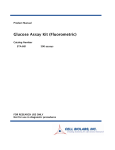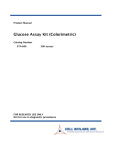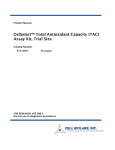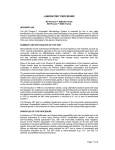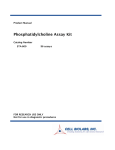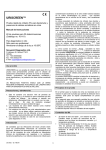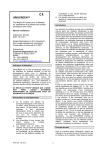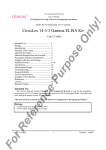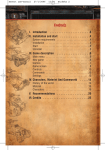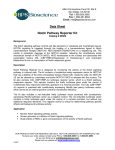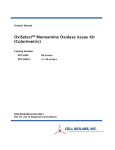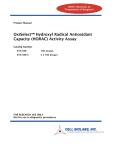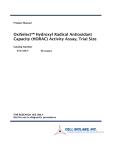Download OxiSelect™ Catalase Activity Assay Kit, Fluorometric, Trial Size
Transcript
Product Manual OxiSelect™ Catalase Activity Assay Kit, Fluorometric, Trial Size Catalog Number STA-339-T 50 assays FOR RESEARCH USE ONLY Not for use in diagnostic procedures Introduction Oxidative stress is a physiological condition where there is an imbalance between concentrations of reactive oxygen species (ROS) and antioxidants. However, excessive ROS accumulation will lead to cellular injury, such as damage to DNA, proteins, and lipid membranes. The cellular damage caused by ROS has been implicated in the development of many disease states, such as cancer, diabetes, cardiovascular disease, atherosclerosis, and neurodegenerative diseases. Under normal physiological conditions, cellular ROS generation is counterbalanced by the action of cellular antioxidant enzymes and other redox molecules. Because of their potential harmful effects, excessive ROS must be promptly eliminated from the cells by this variety of antioxidant defense mechanisms. Hydrogen peroxide is an ROS that is a toxic product of normal aerobic metabolism and pathogenic ROS production involving oxidase and superoxide dismutase reactions. Hydrogen peroxide is poisonous to eukaryotic cells and in high doses can initiate oxidation of DNA, lipids, and proteins, which can lead to mutagenesis and cell death. The cellular damage caused by H2O2 has been implicated in the development of many pathological conditions such as aging, asthma, arthritis, diabetes, cardiovascular disease, atherosclerosis, Down’s Syndrome, and neurodegenerative diseases. Catalase is an antioxidant enzyme omnipresent in mammalian and non-mammalian cells that destroys hydrogen peroxide by dismutation. Eukaryotic catalases are heme enzymes found in the liver, kidney, and erythrocytes in high concentrations while the lowest concentrations are in the connective tissues. The enzyme is concentrated in the peroxisome subcellular organelles. Cell Biolabs’ OxiSelect™ Catalase Activity Assay Kit is a quantitative fluorometric assay for measuring catalase activity from biological samples. The kit employs a simple, sensitive, homogeneous no wash and HTS-compatible assay for measuring catalase activity in samples such as cell lysates, plasma, and tissue homogenates. Catalase-containing samples can be incubated in a known amount of hydrogen peroxide. In the presence of H2O2 and horseradish peroxidase (HRP), non-fluorescent ADHP (10-Acetyl3, 7-dihydroxyphenoxazine) is oxidized to the highly fluorescent Resorufin. ADHP is known as one of the most sensitive and stable fluorogenic probes for detecting H2O2. The probe can be utilized to monitor H2O2 release from cells or enzyme-coupled reactions. The kit has a detection sensitivity limit of at least 30 mU/mL catalase. This Trial Size kit provides sufficient reagents to perform up to 50 assays, including standard curve and unknown samples. Assay Principle The OxiSelect™ Catalase Activity Assay Kit is a sensitive quantitative fluorometric assay for detecting catalase activity. First, catalase induces decomposition of H2O2 to produce water and oxygen (O2). The rate of disintegration of hydrogen peroxide into water and oxygen is proportional to the concentration of catalase (See Reaction 1 in Figure 1). Next, in the presence of HRP, ADHP reacts with the remaining H2O2 in a 1:1 stoichiometry to produce highly fluorescent Resorufin. As the catalase activity increases, the Resorufin signal decreases. The Resorufin product can be easily read by a fluorescence microplate reader with an excitation filter of 530-560 nm and an emission filter of ~590 nm (See Reaction 2 in Figure 1). Fluorescence values are proportional to the catalase levels within the samples. The catalase content in unknown samples is determined by comparison with the predetermined catalase standard curve. 2 Catalase Reaction 1: 2 H2O2 2 H2O + O2 HRP Reaction 2: H2O2 (Remaining) + ADHP Resorufin (Fluorescence) Figure 1. Catalase Reactions Related Products 1. STA-341: OxiSelect™ Catalase Activity Assay Kit (Colorimetric) 2. STA-342: OxiSelect™ ROS Activity Assay 3. STA-343: OxiSelect™ Peroxide Detection Assay (Colorimetric) 4. STA-344: OxiSelect™ Hydrogen Peroxide/Peroxidase Detection Assay (Fluorometric) 5. STA-345: OxiSelect™ ORAC Activity Assay 6. STA-346: OxiSelect™ HORAC Activity Assay Kit Components 1. ADHP Probe (Part No. 234401-T): One 25 μL amber tube of a 10 mM solution in DMSO. 2. HRP (Part No. 234402-T): One 10 μL tube of a 100 U/mL solution in glycerol*. 3. Hydrogen Peroxide (Part No. 234102-T): One 20 μL amber tube of an 8.82 M solution. 4. 10X Assay Buffer (Part No. 234403-T): Two 1.5 mL tubes. 5. Catalase Standard (Part No. 234101-T): One 10 μL amber tube of 600,000 Units/mL**. *Note: One unit is defined as the amount of enzyme that will form 1.0 mg purpurogallin from pyrogallol in 20 seconds at pH 6.0 and 20ºC. **Note: One unit is defined as the amount of enzyme that will decompose 1.0 μmole of hydrogen peroxide per minute at pH 7.0 and 25ºC. Materials Not Supplied 1. Distilled or deionized water 2. 1X PBS for sample dilutions 3. 37ºC incubator 4. Multichannel micropipette reservoir 5. 10 μL to 1000 μL adjustable single channel micropipettes with disposable tips 6. 50 μL to 300 μL adjustable multichannel micropipette with disposable tips 7. Standard 96-well fluorescence black microtiter plate and/or black cell culture microplate 3 8. Fluorescence microplate reader capable of reading excitation in the 530-570 nm range and emission in the 590-600 nm range. Storage Upon receipt, store the ADHP probe and HRP at -20ºC. ADHP is light sensitive and must be stored accordingly. Avoid multiple freeze/thaw cycles. Store the remaining kit components at 4ºC. Preparation of Reagents Note: All reagents must be brought to room temperature prior to use. • 1X Assay Buffer: Dilute the stock 10X Assay Buffer 1:10 with deionized water for a 1X solution. Stir or vortex to homogeneity. • ADHP/HRP Working Solution: Prepare an ADHP/HRP Working Solution by adding ADHP to a final concentration of 100 µM and HRP to a final concentration of 0.4 U/mL in 1X Assay Buffer (e.g. Add 10 µL ADHP stock solution and 4 µL HRP stock solution to 986 µL 1X Assay Buffer). This volume is enough for ~20 assays. The ADHP/HRP Working Solution is stable for 1 day. Prepare only enough for immediate applications. Protect the Working Solution from light. • Hydrogen Peroxide Working Solution: Prepare a Hydrogen Peroxide Working Solution by diluting the stock concentration to 40 µM in 1X Assay Diluent. To prepare the H2O2, first perform a 1:1000 dilution of the stock H2O2 in deionized water. Use only enough for immediate applications (e.g. Add 5 μL of H2O2 to 4.995 mL deionized water). This solution has a concentration of 8.82 mM (8820 μM). Use this 8.82 mM H2O2 solution to prepare a 40 μM H2O2 solution in 1X Assay Buffer (e.g. Add 2.5 µL of the prepared 8.82 mM H2O2 solution to 0.55 mL 1X Assay Buffer). Mix thoroughly. This volume is enough for ~20 assays. The Hydrogen Peroxide Working Solution is stable for 1 day. Prepare only enough for immediate use. Preparation of Samples Notes: • • • • • All samples should be assayed immediately or stored at -80°C for up to 1-2 months. Run proper controls as necessary. Optimal experimental conditions for samples must be determined by the investigator. Always run a standard curve with samples. A serial dilution will be necessary depending on the total H2O2 present. Extremely high levels of H2O2 (≥ 500 µM final concentration) can lower the fluorescence because excess H2O2 can further oxidize the reaction product, Resorufin, to nonfluorescent product Resazurin. Samples with NADH concentrations above 10 μM and glutathione concentrations above 50 μM will oxidize the ADHP probe and could result in erroneous readings. To minimize this interference, it is recommended that superoxide dismutase (SOD) be added to the reaction at a final concentration of 40 U/mL (Tayana et al, Ref. 2). Avoid samples containing DTT or β-mercaptoethanol since Resorufin is not stable in the presense of thiols (above 10 μM). Cell Culture Supernatant: To remove insoluble particles, centrifuge at 10,000 rpm for 5 min. The supernatant can be assayed directly or diluted as necessary. Prepare the catalase standard curve in the same non-conditioned media. Serum samples are not recommended since serum could possibly interfere with the assay. 4 Note: Maintain pH between 7 and 8 for optimal working conditions as the ADHP is unstable at high pH (>8.5). • Cell Lysates: Resuspend cells at 1-2 x 106 cells/mL or tissues at 50 mg/mL in 1X Assay Buffer or PBS. Homogenize or sonicate the cells on ice. Centrifuge to remove debris. The lysate can be assayed undiluted or titrated in 1X Assay Buffer or PBS. • Plasma or Urine: To remove insoluble particles, centrifuge at 10,000 rpm for 5 min. The supernatant can be assayed directly or diluted in 1X Assay Buffer or PBS. Preparation of Standard Curve Use only enough Catalase Standard as necessary for immediate applications. Immediately prior to use, vigorously vortex the Catalase Standard stock vial to obtain a homogenous suspension and immediately remove the desired amount. It is recommended to pipette up and down several times prior to removing the suspension. Prepare fresh standards by diluting the 600,000 Units/mL Catalase Standard stock 1:150 in 1X Assay Buffer for a 4,000 Units/mL solution (eg. Add 5 μL of Catalase Standard stock tube to 745 μL of 1X Assay Buffer). Vortex thoroughly. Further dilute this 4,000 Units/mL solution 1:1000 in 1X Assay Buffer to prepare a 4000 mUnits/mL solution (eg. Add 2 μL of Catalase Standard stock tube to 2 mL of 1X Assay Buffer). Vortex thoroughly. Use the 4000 mUnits/mL solution to prepare a series of catalase standards according to Table 1 below. Note: If crystals are visible upon preparation, gently warm the standards at 30ºC with vortexing. Tubes 1 2 3 4 5 6 7 8 9 10 4000 mUnits/mL Catalase Standard Dilution (μL) 400 300 200 100 50 25 12.5 6.3 3.1 0 1X Assay Buffer (μL) 0 100 200 300 350 375 387.5 393.7 396.9 400 Table 1. Preparation of Catalase Standards 5 Catalase Concentration (mUnits/mL) 4000 3000 2000 1000 500 250 125 62.5 31.3 0 Assay Protocol 1. Prepare and mix all reagents thoroughly before use. Each cell sample, including unknown and standard, should be assayed in duplicate or triplicate. 2. Add 25 µL of catalase standards, controls, and samples into individual microtiter plate wells. 3. Add 25 µL of the 40 μM Hydrogen Working Solution into each microplate well containing standards, samples and controls. Mix thoroughly. 4. Incubate the reaction mixture for 30 minutes at room temperature. 5. Add 50 µL of the ADHP/HRP Working Solution to each well with standards, controls, and samples. Mix the well contents thoroughly and incubate on a shaker for 30 minutes at 37ºC and protected from light. Note: This assay is continuous (not terminated) and therefore may be measured at multiple time points to follow the kinetics of the reactions. 6. Read the plate with a fluorescence microplate reader equipped for excitation in the 530-570 nm range and for emission in the 590-600 nm range. 7. Calculate the activity of catalase within samples by comparing the sample absorbance to the standard curve. Example of Results The following figures demonstrate typical Catalase Activity Assay results. One should use the data below for reference only. This data should not be used to interpret actual results. Figure 2: Catalase Activity Assay Standard Curve. 6 References 1. 2. 3. 4. 5. 6. Mohanty, J.G., et al. J. Immunol. Methods. (1997) 202: 133. Mueller, S., et al. Anal. Biochem. (1997) 245: 55. Tatyana, V., et al. Neurochem. (2001) 79: 266. Votyakova, V., Reynolds, I. Archives of Biochemistry and Biophysics. (2004) 431: 138-144. Zhang, J., et al. Antioxid. Redox Signal. (2001) 3: 493-504. Zhou, M., et al. Anal. Biochem. (1997) 253: 162. Warranty These products are warranted to perform as described in their labeling and in Cell Biolabs literature when used in accordance with their instructions. THERE ARE NO WARRANTIES THAT EXTEND BEYOND THIS EXPRESSED WARRANTY AND CELL BIOLABS DISCLAIMS ANY IMPLIED WARRANTY OF MERCHANTABILITY OR WARRANTY OF FITNESS FOR PARTICULAR PURPOSE. CELL BIOLABS’ sole obligation and purchaser’s exclusive remedy for breach of this warranty shall be, at the option of CELL BIOLABS, to repair or replace the products. In no event shall CELL BIOLABS be liable for any proximate, incidental or consequential damages in connection with the products. Contact Information Cell Biolabs, Inc. 7758 Arjons Drive San Diego, CA 92126 Worldwide: +1 858-271-6500 USA Toll-Free: 1-888-CBL-0505 E-mail: [email protected] www.cellbiolabs.com 2013-2014: Cell Biolabs, Inc. - All rights reserved. No part of these works may be reproduced in any form without permissions in writing. 7








